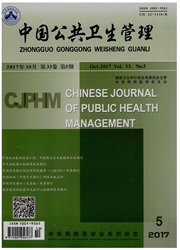

 中文摘要:
中文摘要:
目的探讨5类家庭类型与男、女生15种伤害类型之间的可能关联。方法采用问卷方式调查15种伤害类型的报告率,共调查25 710名12-23岁学生。结果男生:有统计学意义关联的类型占80%。有统计学意义关联的12种伤害类型中,隔代家庭明显高的较多(5种),单亲家庭较高的有2种,单亲家庭、隔代家庭共同较高的有4种。女生:没有统计学意义关联的类型占46.7%。有统计学意义关联的8种伤害类型中,3类不稳定家庭都较高的有2种,重组家庭明显高的有4种。共性:稳定家庭伤害报告率较低;两类稳定家庭相比,大家庭略高于核心家庭。结论男生:有统计学意义关联的类型占80%;12种有统计学意义关联的伤害类型中,隔代家庭明显高的较多(5种),单亲家庭较高的有2种,单亲家庭、隔代家庭共同较高的有4种。女生:没有统计学意义关联的种类占46.7%。有统计学意义关联的8种伤害类型中,3类不稳定家庭都较高的有2种,重组家庭明显高的有4种。共性:稳定家庭伤害报告率较低;两类稳定家庭相比,大家庭略高于核心家庭。
 英文摘要:
英文摘要:
Objective To investigate the relationship between five sorts of family types (FT) and fifteen sorts of injuries types (IT) among male and female students. Methods 25 710 students aged 12 to 23 years old were surveyed with special questionnaires. Results Male: The difference among five FT were significant on 80%( 12/15 )IT. Among the 12 sorts of IT, 5 sorts were obviously high in single-parent family(SPF); 2 sorts were obviously high in grandparents family(GF); other 4 sorts were high both in SF and GF. Female: The difference among five 17F were significant only on 53.3% (8/15) IT. Among the 8 sorts of IT, 2 sorts were high in all sorts of unstable family (UF); other 4 sorts were obviously high in reconstructed family (RF). Both: The rate of UF was higher than stable family. In general, the rates of extended family (EF)were slightly higher than nuclear family(NF). Conclusion UF, male, male from GF or SPF, and female from GF are the focus of injurie control interventions.
 同期刊论文项目
同期刊论文项目
 同项目期刊论文
同项目期刊论文
 期刊信息
期刊信息
